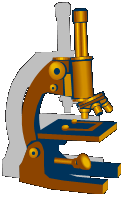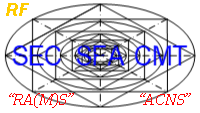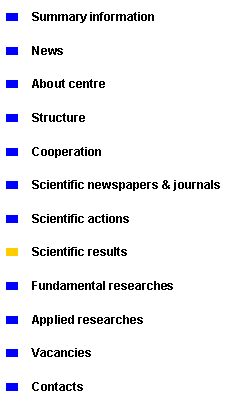The sphere of scientific interests
of “SEC "SFA CMT"
of "RA(M)S" n. a. acad. Burdenko N.N.”
includes:
the clinical medicine (14.01.00),
the preventive medicine (14.02.00),
the medical-biological sciences (14.03.00),
the pharmaceutical sciences (14.04.00),
the chemical sciences in the medicine (02.00.00),
the biological sciences in the medicine (03.00.00),
the psychological sciences in the medicine (19.00.00),
the physical-mathematical sciences
in the medicine (01.02.00),
the technical sciences in the medicine (05.00.00),
the economic sciences in the medicine (08.00.00),
in particular:
the (microscopic) system analysis
and control,
the information technologies,
the information-educational environments,
the automated training systems
(at distance),
the innovative architectures and algorithms
in the basis of the automation training means,
(cognitive) informatics,
the psychophysiology of perception,
(cognitive) psychology,
(cognitive) linguistics,
the (microscopic) financial analysis,
accounting and audit
of the enterprises and (credit) organizations,
theoretical mechanics,
physical chemistry
and molecular biology.
The director of “SEC "SFA CMT"
of "RA(M)S" n. a. acad. Burdenko N.N.”
has developed the dissertation
“The environment of automated training
with the properties of adaptation
based on the cognitive models”
on the competition of scientific degree
of the doctor of technical sciences
on spec. 05.13.01 – “The system analysis,
control and information processing”
and 19.00.02 – “Psychophysiology of perception”
(19.00.03 – “Psychology of work,
engineering psychology and ergonomics”)
and the methodical maintenance
of the discipline “Informatics”,
and also there were carried out
the experimental researches
of the information environment
of automated training,
it was possible to made the significant contribution
into the development of “Technics”
(theory and practice).
I. At the present moment of time
“SEC "SFA CMT"
of "RA(M)S" n. a. acad. Burdenko N.N.”
were received the following
theoretical and practical
scientific results in the area
of “Technics”, “Technology”
and “The system analysis”.
1.1. The environment of automated training
with the properties of adaptation
based on the cognitive models:
· the modifications in the organization
of the information-education environment
based on the parametrical
cognitive models block;
· the modifications in the technology
of the information-education environment
based on the parametrical
cognitive models block.
1.2. The cognitive modeling technology
for the (microscopic) system analysis
of the information-education environments,
including:
· the technique of its use;
· the ways of representation
of the structure of the cognitive model;
· the algorithm of formation
of the cognitive models;
· the technique of research of the parameters
of the cognitive models of the subject of training;
· the technique of research of the parameters
of the cognitive models of the means of training;
· the algorithm of processing
of a posteriori results of testing
of the level of residual knowledge
of the contingent of trainees
and the diagnostics of the individual
features of the contingent of examinees.
1.3. The parametrical cognitive models block
as the information basis
of the (microscopic) system analysis
of the information-education environment,
including:
· the cognitive model of the subject of training;
· the cognitive model of the means of training.
1.4. The structure of the complex of programs
as the means of automation
of the (microscopic) system analysis
of the information-education environment
and the automated training system
with the properties of adaptation
based on the cognitive models,
including:
· the adaptive means of training
(the electronic textbook)
based on the adaptive representation
of information fragments
processor;
· the basic diagnostic module;
· the applied diagnostic module.
1.5. The statistical justification (substantiation)
of a posteriori data
of the (microscopic) system analysis
of the information-educational environment:
· the features of the primary processing
of a posteriori data;
· the descriptive statistics
of a posteriori data of research
of the physiological, psychological
and linguistic portraits
of the cognitive models;
· the choice of the methods
of the statistical analysis
of a posteriori data
of a series of experiments;
· the calculation of the indicators of correlation;
· the calculation of the indicators of covariation;
· the results of the dispersion analysis;
· the results of the regression analysis;
· the results of the discriminant analysis;
· the results of the multivariate scaling;
· the results of the hierarchical
cluster analysis;
· the results of the factor analysis.
1.6. The generalized results
of the dynamics of changing
of the resultativity of functioning
of the information-educational environment
and the increasing of efficiency
of the automated training system
with the properties of adaptation
based on the parametrical
cognitive models block.
The conception of integration
of the environment of automated training
with the properties of adaptation
based on the cognitive models
into the information-educational environment
of the establishment of the system of education
of the modern country was developed.
The director of “SEC "SFA CMT"
of "RA(M)S" n. a. acad. Burdenko N.N.”
was developed the dissertation
“The cognitive modeling technology
for the financial analysis and audit of the organization”
on the competition of scientific degree
of the doctor of economic sciences
on spec. 08.00.10 – “Finance,
monetary circulation and credit”,
and also there were carried out the researches
of the enterprises and (credit) organizations,
it was possible to made
the essential contribution
into the development of “Economics”
(theory and practice).
II. At the present moment of time
“SEC "SFA CMT"
of "RA(M)S" n. a. acad. Burdenko N.N.”
were received the following
theoretical and practical
scientific results in the area
of “Economics” and “The (microscopic)
financial analysis and audit”.
2.1. The vertically and horizontally integrated
organizational structures of the enterprise
and (credit) organization
as the managing subjects
of the economic system of the country.
2.2. The cognitive modeling technology
for the (microscopic) financial analysis
and audit
of the enterprise and (credit) organization,
including:
· technique of its use;
· the ways of representation
of the structure of the cognitive model;
· the algorithm of formation
of the cognitive models;
· the technique of formation
of the normative-legal basis
of the (microscopic)
financial analysis and audit
of the enterprise and (credit) organization;
· the technique of formation
of the information basis
of the (microscopic)
financial analysis and audit
of the enterprise and (credit) organization;
· the technique of additional check
of the information basis
of the (microscopic)
financial analysis and audit
of the enterprise and (credit) organization;
· the technique of research of the parameters
of the cognitive model
for the vertical financial analysis;
· the technique of research of the parameters
of the cognitive model
for the horizontal financial analysis;
· the technique of research of the parameters
of the cognitive model
for the trend financial analysis
based on the analytical coefficients system;
· the algorithm of processing
of a posteriori results
of the vertical, horizontal and trend
financial analysis and audit,
and also the estimation
of the efficiency of functioning
of the enterprise and (credit) organization
based on the primary registers
of the accounting
and the financial analysis.
2.3. The parametrical cognitive models block
as the information basis
of the (microscopic) financial analysis
and audit
of the enterprise and (credit) organization,
including:
· the cognitive model
for the vertical financial analysis
of the enterprise and (credit) organization;
· the cognitive model
for the horizontal financial analysis
of the enterprise and (credit) organization;
· the cognitive model
for the trend financial analysis
of the enterprise and (credit) organization
based on the analytical coefficients system.
2.4. The structure of the complex of programs
as the means of automation
of the (microscopic) financial analysis
and audit
of the enterprise and (credit) organization,
including:
· the means of automation of formation
of the working plan of accounts
based on the normative-regulated
plan of accounts of the accounting
of the enterprise and (credit) organization;
· the means of automation of formation
of the accounting balance
and the report about profits and losses
of the enterprise and (credit) organization;
· the means of automation
of the vertical financial analysis
of the enterprise and (credit) organization;
· the means of automation
of the horizontal financial analysis
of the enterprise and (credit) organization;
· the means of automation
of the trend financial analysis
of the enterprise and (credit) organization
based on the analytical
coefficients system.
2.5. The statistical justification (substantiation)
of a posteriori data
of the (microscopic) financial analysis
and audit
of the enterprise and (credit) organization:
· the features of the primary processing
of a posteriori data;
· the descriptive statistics
of a posteriori data
based on the cognitive models
for the vertical, horizontal
and trend financial analysis
based on the analytical
coefficients system;
· the choice of methods of the statistical analysis
for the processing of a posteriori data;
· the calculation of the indicators of correlation;
· the calculation of the indicators of covariation;
· the results of the dispersion analysis;
· the results of the regression analysis;
· the results of the discriminant analysis;
· the results of the multivariate scaling;
· the results of the hierarchical
cluster analysis;
· the results of the factor analysis.
2.6. The generalized results
of the dynamics of changing
of the resultativity (the increasing of efficiency)
of the (microscopic) financial analysis
and audit
of the financial-economy activity
of the enterprise and (credit) organization.
The conception
of the (microscopic) financial analysis and audit
of the organizational structure
of the enterprise and (credit) organization
based on cognitive modeling
technology was developed.
The director of “SEC "SFA CMT"
of "RA(M)S" n. a. acad. Burdenko N.N.”
was developed the dissertation
“The cognitive modeling technology
for the complex analysis of the difficult
objects, processes and phenomena”
on the competition of scientific degree
of the doctor of physical-mathematical sciences
on spec. 01.02.01 – “Theoretical mechanics”,
there were carried out the researches
of the difficult objects, processes and phenomena,
it was possible to made
the contribution into the development
of “Theoretical mechanics”,
“Physics-mathematical sciences”
(theory and practice).
III. At the present moment of time
“SEC "SFA CMT"
of "RA(M)S" n. a. acad. Burdenko N.N.”
were received the following
theoretical and practical
scientific results in the area
of “Theoretical mechanics”
and “Physical-mathematical sciences”
(the genesis and practical use
of the (multidimensional) cognitive circle,
cognitive disc, cognitive cylinder,
cognitive cone, cognitive sphere
and others).
3.1. The cognitive circle, cognitive disc,
cognitive cylinder, cognitive cone,
cognitive sphere
and the one-, two-, three-, four-, five- and more
cognitive sphere
for the (microscopic) complex analysis
of the difficult objects, processes and phenomena.
3.2. The cognitive modeling technology
for the (microscopic) complex analysis
based on the cognitive circle,
cognitive disc, cognitive cylinder,
cognitive cone, cognitive sphere
and the one-, two-, three-, four-, five- and more
cognitive sphere,
including:
· the technique of its use;
· the ways of representation
of the structure of the cognitive circle,
cognitive disc, cognitive cylinder,
cognitive cone, cognitive sphere
and the one-, two-, three-, four-, five- and more
cognitive sphere;
· the algorithm of formation
of the cognitive circle;
· the algorithm of formation
of the cognitive disc;
· the algorithm of formation
of the cognitive cylinder;
· the algorithm of formation
of the cognitive cone;
· the algorithm of formation
of the cognitive sphere;
· the algorithm of formation
of the one-, two-, three-, four-, five- and more
cognitive sphere;
· the technique of formation
of the normative-technical basis
of the cognitive circle, cognitive disc,
cognitive cylinder,
cognitive cone, cognitive sphere
and the one-, two-, three-, four-, five- or more
cognitive sphere;
· the technique of formation
of the information basis
of the cognitive circle, cognitive disc,
cognitive cylinder,
cognitive cone, cognitive sphere
and the one-, two-, three-, four-, five- or more
cognitive sphere;
· the technique of additional check
of the information basis
of the cognitive circle, cognitive disc,
cognitive cylinder,
cognitive cone, cognitive sphere
and the one-, two-, three-, four-, five- or more
cognitive sphere for the complex analysis;
· the technique of research of the parameters
of the cognitive model
based on the cognitive circle;
· the technique of research of the parameters
of the cognitive model
based on the cognitive disc;
· the technique of research of the parameters
of the cognitive model
based on the cognitive cylinder;
· the technique of research of the parameters
of the cognitive model
based on the cognitive cone;
· the technique of research of the parameters
of the cognitive model
based on the cognitive sphere;
· the technique of research of the parameters
of the cognitive model
based on the one-, two-, three-, four-, five-
and more cognitive sphere;
· the algorithm of processing
of a posteriori results
of the (microscopic) complex analysis
of the difficult objects,
processes and phenomena.
3.3. The parametrical cognitive models block
as the information basis
of the (microscopic) complex analysis
of the difficult objects, processes and phenomena,
including:
· the cognitive model
based on the cognitive circle;
· the cognitive model
based on the cognitive disc;
· the cognitive model
based on the cognitive cylinder;
· the cognitive model
based on the cognitive cone;
· the cognitive model
based on the cognitive sphere;
· the cognitive model
based on the one-, two-, three-, four-, five-
and more cognitive sphere.
3.4. The structure of the complex of programs
as the means of automation
of the (microscopic) complex analysis
of the difficult objects, processes and phenomena,
including:
· the means of automation
of formation and research
of the cognitive circle;
· the means of automation
of formation and research
of the cognitive disc;
· the means of automation
of formation and research
of the cognitive cylinder;
· the means of automation
of formation and research
of the cognitive cone;
· the means of automation
of formation and research
of the cognitive sphere;
· the means of automation
of formation and research
of the one-, two-, three-, four-, five- and more
cognitive sphere;
· the means of automation
of the (microscopic) complex analysis
of the difficult objects, processes and phenomena
based on the cognitive circle;
· the means of automation
of the (microscopic) complex analysis
of the difficult objects, processes and phenomena
based on the cognitive disc;
· the means of automation
of the (microscopic) complex analysis
of the difficult objects, processes and phenomena
based on the cognitive cylinder;
· the means of automation
of the (microscopic) complex analysis
of the difficult objects, processes and phenomena
based on the cognitive cone;
· the means of automation
of the (microscopic) complex analysis
of the difficult objects, processes and phenomena
based on the cognitive sphere;
· the means of automation
of the (microscopic) complex analysis
of the difficult objects, processes and phenomena
based on the one-, two-, three-, four-, five-
and more cognitive sphere.
3.5. The statistical justification (substantiation)
of a posteriori data
of the (microscopic) complex analysis
of the difficult objects, processes and phenomena:
· the features of the primary processing
of a posteriori data;
· the descriptive statistics
of a posteriori data
based on the cognitive circle,
cognitive disc, cognitive cylinder,
cognitive cone, cognitive sphere
and the one-, two-, three-, four-, five- and more
cognitive sphere;
· the choice of the methods
of the statistical analysis
for the processing of a posteriori data;
· the calculation of the indicators of correlation;
· the calculation of the indicators of covariation;
· the results of the dispersion analysis;
· the results of the regression analysis;
· the results of the discriminant analysis;
· the results of the multivariate scaling;
· the results of the hierarchical
cluster analysis;
· the results of the factor analysis.
3.6. The generalized results
of the dynamics of changing
of the resultativity (the increasing of efficiency)
of functioning of the difficult object,
technological process
(technological step) and phenomenon.
The conception
of the (microscopic) complex analysis
of the difficult object, process and phenomena
based on the cognitive modeling
technology was developed.




